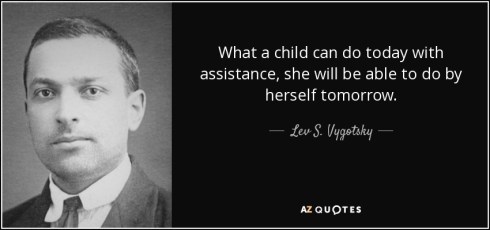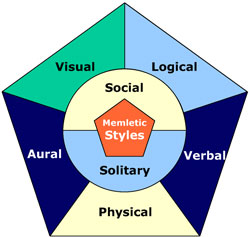In one of my many gchats with an old friend, the concept of the Zone of Proximal Development (ZPD) came up, and I went squirreling off in search of this fascinating education theory. In it, Lev Vygotsky offers a way for us to understand the value of peer teaching, which appears in all good dojos around the world: the sempai-kouhai relationship.
What is the Zone of Proximal Development?
Basically it is a system that puts students within the orbits of those who are best placed to help them depending on the subject material and their learning styles.
Lev Vygotsky views interaction with peers as an effective way of developing skills and strategies. He suggests that teachers use cooperative learning exercises where less competent children develop with help from more skillful peers – within the zone of proximal development.
Vygotsky believed that when a student is in the ZPD for a particular task, providing the appropriate assistance will give the student enough of a “boost” to achieve the task. – Saul McLeod (emphasis mine)

Or, as Vygotsky himself wrote,
“the distance between the actual developmental level as determined by independent problem solving and the level of potential development as determined through problem solving under adult guidance, or in collaboration with more capable peers” (Vygotsky, 1978, p86).
It is a far less top-down method of teaching, instead employing the collective to help scaffold a learner until they can solve the problem themselves. While the term ‘scaffolding’ was not used by Vygotsky himself, scholars after him created it as a tidy term to explain the way others can build a support structure for another learner until they can solve the problem themselves.
Wood et al. (1976, p. 90) offer the following definition of scaffolding:
‘Those elements of the task that are initially beyond the learner’s capacity, thus permitting him to concentrate upon and complete only those elements that are within his range of competence’.
Basically, put people with others who are best placed to help them – teachers, students, parents. But for our purposes, let’s stick to peers.
Okay, that’s nice, but what does it have to do with martial arts?
Have you ever been in the dojo, or at a gashuku, or just sitting with dojo mates, and  someone just explains something in a way that clicks?
someone just explains something in a way that clicks?
We know that there are 7 different styles of learning, and a good instructor tries their best
to cover as many of these as possible. We tend to use visual, verb and logical cues.
But in a class with many students of different abilities and understandings, sometimes it helps to crowdsource a better explanation.
Within the classroom, the person who is more knowledgeable is not always the teacher; students can also be placed in collaborative groups with others who have demonstrated mastery of tasks and concepts.- Heather Coffey
I myself am a more social, verbal learner, and sometimes someone just says something that explains one problem beautifully. But others might need just that one physical correction – a touch to a floating elbow, maybe – and the problem is highlighted and therefore solvable.
In your dojo, you have a variety of intelligences, and while we shouldn’t expect our little champs to be good teachers, this is vital to introduce into your dojo from about the age of ten. I have an orange belt, who is ten years old and an exceptional fixer of stances. I have never seen someone so dedicated to working with his peers to fix their footwork. When it comes time to pair them off, I know who I can rely on to spot that issue and fix it in another student.
What are the benefits of the Sempai-Kouhai relationship?
Briefly, Sempai-Kouhai is basically a mentor/student relationship. It has overtones of big sibling, little sibling – a gentle way to teach students to take responsibility and pride in the success of their classmates. Once in awhile, pairing seniors with juniors can yield many fruitful results.
The Sempai-Kouhai relationships uses scaffolding as a way for a more junior student to learn from the higher student. Perhaps it is the first 10 moves of a kata that the sempai knows well. By letting them work with a junior, you teach them how to improve their own kata along the way.
To teach is to learn twice – this is one of the major advantages of a Sempai-Kouhai pairing. Below, some benefits that I have gleaned over the course of my uchi-deshi course and in the dojo over a decade:
- Building esprit de corps
- Leadership through gentle mentorship
- Learning to give and receive criticism – feed forward, not back
- The sempai realises that teaching isn’t as easy as it looks
- By being able to sit out and watch for a bit, it is an excellent way for the instructor to pick up on problems – whether something was inadequately explained, or there’s a general problem preventing further progress
- Likewise, it also gives instructors a tool to manage the need to micromanage students. An instructor is a gardener, not a carpenter.
- Building confidence for both sempai and kouhai
- More rank, more responsibility – teaching the value of dojo hierarchy
- Engendering patience and kindness towards fellow students
- Learning to use different pieces of dojo equipment to fix or explain a problem
- Taking pride in the dojo through teaching juniors
- Awareness of the depth of understanding required to be a good teacher
- Responsibility is more important than technical perfection: we can always fix the technique later, because we are building people, not robots
- Humility
- It helps splits up the syllabus on those occasions when there is a wide split in abilities in the class
Over the years I have been immensely fortunate to have seniors along the way that have been integral to my martial arts journey. From my first Sempai, who ignited my love of kata and general martial arts studies (thanks for all those wonderful Sunday training sessions, by the way) to all the seniors I have now from whom I learn each day. In South Africa, we have a term for this: ubuntu: I am, because you are. The idea of collective growth, love and support is beautifully encapsulated in this phrase, and I love to pair it with ZPD.
Of course, our instructors will always be important, but we can learn from everyone in the dojo. To sum it all up: I am, because you are, to teach is to learn twice, and so we can scaffold each other to greater heights.
Do you have a sempai that has hugely affected your martial arts journey? A kouhai you’re proud of? Please share your stories in the comments below.
Further Reading:
An Introduction to Vygotsky edited by Harry Daniels
The Zone of Proximal Development by Heather Coffey
